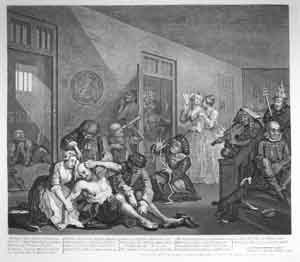|

Frenchman Philippe Pinel argued in the late 18th century that confining the mentally ill to jails, pens, cellars and garrets, restraining them in chains, straight jackets and chairs, feeding them bread and water, and hiring attendants based on their strength and not their compassion or medical training, was unacceptable. Sparking a revolution in the treatment of the mentally ill, Pinel's ideas were discussed by Missouri legislators in 1845. Nevertheless, the state continued to use the "letting out" system whereby counties placed their mentally ill in the care of the lowest bidder. In 1849, the chairman of the House Committee on the Lunatic Asylum described this practice as one virtually guaranteed to foster coercion and to provide patients the same type of care given to wild animals.

"The Interior of Bedlam," from A Rake's Progress by William Hogarth, 1763.
McCormick Library, Northwestern University
|